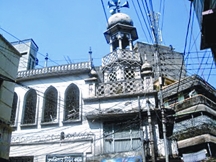Churihatta Mosque, Dhaka
Churihatta Mosque, Dhaka situated in the Churihatta area on the west of Chwak Mosque in old Dhaka. Evidenced by a Persian inscription, the mosque was built by one Muhammad Beg in 1650 AD (AH 1060) during the viceroyalty of shah shuja. In 2008 the mosque had been completely destroyed and at that place a new multi stories new mosque had been erected there. A spacious verandah had been added along the north, south and eastern sides. A flat roof has replaced the original chau-chala roof of the mosque and two more stories built above it.

Professor AH Dani in his book 'Dhaka' described the original structure of Churihatta mosque. The original building is oblong in plan and its four exterior angles were strengthened with octagonal towers, no longer extant. Arched doorways - three on the east and one each on the north and south sides provided entrance to the mosque. Inside the qibla wall there were three mihrabs, of which only the central one now survives. It is of semi-octagonal design set within a rectangular frame, which is topped by a frieze of blind crestings. The mosque was covered with a chau-chala hut type of roof, now made flat. The eastern facade was adorned with square and rectangular panels and the parapet faced with blind merlons.
Mirza Nathan frequently mentioned in his baharistan-i-ghayibi that the Mughals constructed buildings of the Bungalow type in Bengal, covered either with chau-chala or with do-chala vaults. Unfortunately only a few of them exist today, and are either mosques or tombs, or annexes to mosques. The present Churihatta mosque, entirely covered with a chau-chala vault, provides the earliest extant example of an independent Bungalow type of building in Mughal Bengal. The very name Bungalow indicates that it is of Bengali origin and takes its derivation from the chau-chala huts of the land. In Bengal the chau-chala hut roof was first translated in brick architecture by the Sultanate craftsmen, noticed for the first time over the central nave of the shatgumbad mosque (c.mid-15th century) at Bagerhat. Independent chau-chala roofed building in Bengal also first appeared during the Sultanate period. It's only known example being the Shabekdanga building at Bagerhat, supposed to have been built in the Husain Shahi period.
By analysing the Inscription and the presence of chau-chala roof, Dr. Abdul Karim stated that probably the building was built initially as a temple and then it was turned into a mosque. It is also believed that, Muhammad Beg built the mosque on the ruin of a temple of Hindu-Buddhist era. An Idol of Basu Deva was found here under the ruin by excavating the place in 1906 (the Idol is now kept in the Calcutta Museum). Churihatta mosque is now only a 'History'; because the old mosque is no longer exist, rather than a modern mosque complex. [MA Bari]
